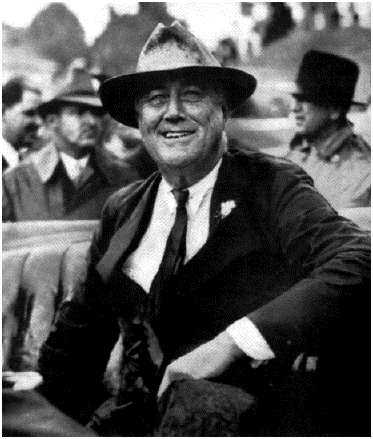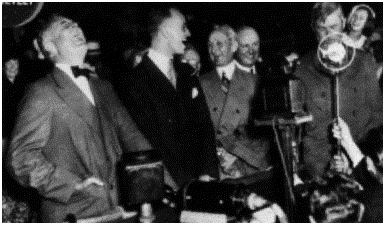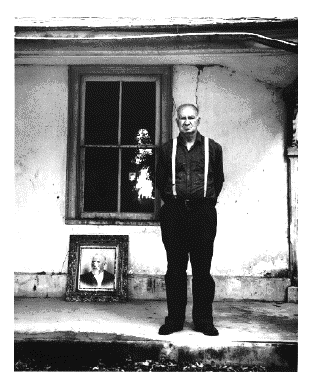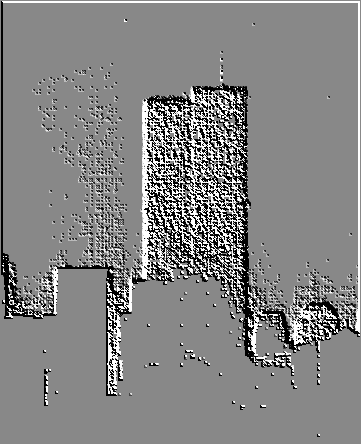FDR in Photographs
Hugh Gregory Gallagher
(Wendamere Press)

Roosevelt was a man of much promise (and a regal air) who, at the age of forty-one, suddenly found himself profoundly disabled. In those days, the disabled were expected to live unseen in the back room (or in Roosevelt's case, to retire his spread on the Hudson.) To the able-bodied world, disability of the body implied disability of the mind. The operative word was "crippled," whose etymological roots are crypel --- "creeper."
One could be expected to be treated --- if not warehoused --- in places with names like "New York Society for the Relief of the Ruptured and Crippled" or "Children's House of the Home for Incurables." FDR thus not only had to shake off a widespread prejudice against his condition and the reaction of his own family --- but the distaste of the world at large.
Starting with his early post-illness campaigns, he and his supporters orchestrated an appearance of full recovery. This artful sleight- A visible paralytic handicap affects every relationship, alters the attitudes of others, and challenges one's self-esteem. It requires meticulous minute- Because of this trickery, Gallagher claims that by the end of his presidency, Roosevelt might well have been in the toils of an emotional depression which may have contributed to his demise --- and which certainly affected his last two years in office. We'll never know for sure: those around him were loyal, loyal to the deception long after his passing from the scene. Still, those of us who are disabled owe him much. By the time of his death, we were expected not to hide, but to rise up, to do damn near anything we wanted, to demand recognition for what we were, as well as for what we were not supposed to be. With great enthusiasm and great cheer, we were to overcome whatever it was that got us; to never look back. In Nothing to Fear, Gallagher is lucid, direct, and learned. His first chapter is an evocation of the inaugural of 1933, and is wonderfully written: In a single day, every bank in Chicago went bust. In Michigan, the governor ordered all banks to shut their doors. With their savings gone, millions of people, jobless and homeless for the first time, lived on the streets and depended on soup kitchens to stay alive. The city of Chicago was broke and paid its schoolteachers in scrip. People bartered for food and fuel; people paid for things with IOUs....America, the hope of the world, was on its knees. American democracy, the great experiment, seemed doomed to failure. The author concludes: Roosevelt had spoken of conquering fear and the paralysis it brings. Few noted that these were things he knew well. For in fact, FDR was paralyzed from the waist down and used a wheelchair. He could stand only with the help of long leg braces, leaning on the strong arm of a strong man, steadying himself with a cane.. "A crippled America," he observes, " had chosen a crippled president to lead it." Nothing to Fear is a photographic document that emphasizes Roosevelt's early days, his sickness, his time at Warm Springs, and his presidency. Much of it treats the two main challenges of his time in office: the depression of the 30s, and WWII. Gallagher's profound insight was that we pay a high price for such a deception. FDR showed the world a carefully constructed cheerfulness, but it required an immense amount of work to maintain this dissembling.
Gallagher's profound insight was that we pay a high price for such a deception. FDR showed the world a carefully constructed cheerfulness, but it required an immense amount of work to maintain this dissembling. There are over 150 photographs in the volume, many of which are wonderfully evocative. However, if there are future editions (and we do hope there will be), we would suggest that the publisher seek a printer who will take the effort to reproduce his photographs as they should be reproduced --- so that the shots don't look like something left over from a throwaway hastily put together by Pacers, our local strip club down on Broadway, trying to lure us in the door.
There are over 150 photographs in the volume, many of which are wonderfully evocative. However, if there are future editions (and we do hope there will be), we would suggest that the publisher seek a printer who will take the effort to reproduce his photographs as they should be reproduced --- so that the shots don't look like something left over from a throwaway hastily put together by Pacers, our local strip club down on Broadway, trying to lure us in the door.
Missing
Dan Chaon
(Ballentine)

Sandi worries about going crazy. There's a janitor where she works who looks like Safety Man, and she thinks "I am an insane person." Once, she realizes that she's not really "one of them." Going home, Safety Man sits serenely beside her, "gazing forward like a noble sea captain."
"You're doing fine," Safety Man tells her. "Everyone thinks so. You can go on like this for a very long time, and no one will notice. You keep thinking you are going to hit some sort of bottom, but I'm here to tell you. There is no bottom."
There are twelve stories here, and they are elegant --- so well wrought --- that we don't want them to stop. Chaon writes about people who are misunderstood, inchoate, uncertain. They get old and drink too much and communicate badly --- and they smoke as much as any of J. D. Salinger's characters ever did.
A short story --- unless it comes from Henry James --- must not tell too little nor too much. The pacing must be artful. In Chaon, there are overtones of psychology, but none of it embarrasses us. Rather, it shines a bit of extra light on what is happening:
"Displaced emotions," she said, rolling her eyes. "Oh, please. What does that mean exactly?"
He smiled a little, as if he knew more than he was willing to say. They were washing dishes, and he handed her a plate to dry. "It means," he said, "that you're not worried about what you think you're worried about."
These are regular people in regular jobs --- firemen, bureaucrats, telephone operators, bartenders. They are painted with a fine brush:
"Damn it, Everett," I heard my mother say sharply, and I smiled because the phrase was so familiar, and because I knew it would make him blush and grow sullen. His real name was Everett, but everyone called him Shorty --- he was five foot five, a compact, wiry little man --- and some time in the distant past he'd come to see his nickname as a kind of badge of respect, and Everett as an insult, a sissified embarrassment. Even my mother used it only in anger.
In one paragraph, we have a man who is short and proud, a man who fights with his wife who, in turn, uses expert techniques to get to him.
The Big Theme --- if we can call it that --- tells us that you and I will never know someone, even wife or friend or son. We can try to figure out why people do what they do, but there will always be The Mystery. This is Sean and his father, talking about a carload of people --- father, mother, children --- who drove into a nearby lake and perished (the lake was not that deep; they could have escaped). Sean wonders why they did it.
"Why do people do anything, Sean?" He looked at me, a slow, drunken film over his eyes, a sad and scornful look. "Do you think you can say why people do what they do? They teach you that in college?" He looked at me thoughtfully, and later, when I was older, it was something I recalled, that expression. It was the stare of a man who has realized that he doesn't know his son and his son doesn't know him.
A local mystery turns into a potent symbol for a family that can't communicate, living in a locked and isolated box where there is no escape.
Many have written on these subjects but few, I suggest, have done it with such aplomb --- a dry, pregnant style that is so direct it hurts.
A Spiritual Response
To the Attack on America
Collected by the
Editors of Beliefnet
(Rodale/St. Martins)

The famous and the not-so- Rabbi David Wolpe calls on us to be angry (at ourselves, at God) and to not forget the lessons on the concentration camps --- that when we are powerless we are victims. Andrew Greeley asks "Where was God on September 11?" but reminds us that those who call it "the worst disaster in American history" are forgetting Antietam or Cold Harbor. Rabbi Shmuley Boteach cites the "utter conceit" of those who blame gays, who accuse those who try to ban prayers from schools --- those, in sum, who believe they "know the mind of God." Thom Hartmann reminds us of the memories the Muslims have of the Crusades, where, in the words of a contemporary, the Christians cut off the heads of their enemies; others shot them with arrows, so that they fell from the towers; others tortured them longer by casting them into the flames. Piles of heads, hands, and feet were to be seen in the streets of the cities...in the temple and portico of Solomon, men rode in blood up to their knees and bridle reins. Roger Kamenetz says that our anger may serve only to isolate us from others, and concludes, Our anger costs us every time we use it. There's no simple end to it. There is no simple answer, and those who, in their rage, think there is are turning themselves into what they hate. Lama Surya Das reminds us that "the Afghani people are starved, exhausted, incapacitated, suffering, even as one billion people on our planet are starving and one-third of the world's population is suffering from hunger today." A few years ago, the United Nations estimated that there are 500,000 disabled orphans in Afghanistan --- a country with no economy, no food, and millions of widows. And Rogat Loeb points out that "The ordinary Americans whose inexcusable deaths rend our hearts may have died in part because of our own government's past actions." ...something turned the hijackers. Maybe it was watching corrupt dictatorships like the Saudi Arabia inviting U. S. bases onto their soil. Maybe it was seeing Palestinians shot and bombed by Israeli soldiers with American backing. Maybe it was the Gulf War and the one million Iraqis who have died because the war and our continuing embargo have destroyed their most basic health and sanitation systems. Or our bombing of Sudan's only pharmaceutical factory, on what turned out to be false charges that it was producing biological weapons... In an article in the New York Times, Stephen King suggested that for less than $100 in weaponry, nineteen men were able to take over the media of the United States for weeks. They also have changed, forever, the way we view the day's mail, air travel, men with beards, Islam, tall buildings, the city of New York, the Middle East, crop-dusters, our rights against unwarranted search and seizure, and our president. A surprising spirit of forgiveness permeates A Spiritual Response. Needless to say, it has yet to reach the halls or hearts of our leaders.